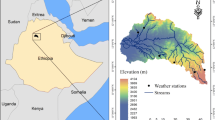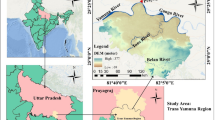Abstract
The purpose of this work was to calculate the relationships between radon levels in groundwater and spatial factors (e.g., geology, topography, soil, and geochemistry), to integrate these relationships, and to map the radon potential levels using a probabilistic method and geographic information systems (GIS) in Yongin, Korea. Radon in groundwater is affected by topographic factors such as elevation and slope, geological factors such as lithology and geochemical factors. A spatial database containing radon, topographic, soil, geological and geochemical data was compiled for the study area using GIS. We then extracted 33 factors from geological maps, topographic maps, and geochemical data. The relationships between radon occurrence and these factors were evaluated using the frequency ratio method, which is one of a probabilistic model. Seven of factors (electrical conductivity (EC), SiO2, Sr, NO3, HCO3, DEM, and geology) had close relationships with 222Rn occurence and were combined to produce a radon potential map using spatial overlay. This radon potential map was validated by comparing with the existing occurrences of radon gas. Of the total number of radon occurrences, 50% were used for mapping, and the remaining 50% were used for model validation. The average radon potential index (RPI) value with radon concentration greater than radon content criterion was 43.69% higher than its average RPI value less than the criterion value in our samples. The average RPI value was 43.96% higher than US EPA’s alternative maximum contaminant level of 148 Bq/L. The radon potential map constructed in this study can serve as an important reference for potential radon exposure.





Similar content being viewed by others
References
Akkala A, Devabhaktuni V, Kumar A, Bhatt D (2011) Development of an ANN interpolation scheme for estimating missing radon concentrations in Ohio. Open Environ Biol Monit J 4:21–30
Appleton JD, Miles JCH (2010) A statistical evaluation of the geogenic controls on indoor radon concentrations and radon risk. J Environ Radioact 101(10):799–803
Bossew P, Dubois G, Tollefsen T (2008) Investigations on indoor Radon in Austria, part 2: geological classes as categorical external drift for spatial modelling of the Radon potential. J Environ Radioact 99(1):81–97
Bossew P, Žunić ZS, Stojanovska Z, Tollefsen T, Carpentieri C, Veselinović N, Komatina S, Vaupotič J, Simović RD, Antignani S, Bochicchio F (2014) Geographical distribution of the annual mean radon concentrations in primary schools of Southern Serbia—application of geostatistical methods. J Environ Radioact 127:141–148
Ciotoli G, Voltaggio M, Tuccimei P, Soligo M, Pasculli A, Beaubien SE, Bigi S (2017) Geographically weighted regression and geostatistical techniques to construct the geogenic radon potential map of the Lazio region: a methodological proposal for the European Atlas of Natural Radiation. J Environ Radioact 166(2):355–375
Ding Q, Chen W, Hong H (2017) Application of frequency ratio, weights of evidence and evidential belief function models in landslide susceptibility mapping. Geocarto Int 32(6):619–639
Drolet JP, Martel R, Poulin P, Dessau JC, Lavoie D, Parent M, Lévesque B (2013) An approach to define potential radon emission level maps using indoor radon concentration measurements and radiogeochemical data positive proportion relationships. J Environ Radioact 124:57–67
Drolet JP, Martel R, Poulin P, Dessau JC (2014) Methodology developed to make the Quebec indoor radon potential map. Sci Total Environ 473–474:372–380
Ferrier KL, Kirchner JW (2008) Effects of physical erosion on chemical denudationrates: a numerical modeling study of soil-mantled hillslopes. Earth Planet Sci Lett 272(3–4):591–599
Gruber V, Bossew P, De Cort M, Tollefsen T (2013) The European map of the geogenic radon potential. J Radiol Prot 33(1):51–60
Lee S, Choi J (2004) Landslide susceptibility mapping using GIS and the weight-of evidence model. Int J Geogr Inf Sci 18(8):789–814
Lee SM, Kim HS, Song YS (1989) Explanatory note of the ANSONG sheet. Korean Institute of Geoscience and Mineral Resources, Daejeon, pp 1–18
Lee BJ, Kim YB, Lee SL, Kim JC, Kang PJ, Choi HI, Jin MS (1999) Explanatory Note of the Seoul-Namchonjeom Sheet. Korean Institute of Geoscience and Mineral Resources, Daejeon, pp 1–64
Lee S, Choi JK, Park I, Koo BJ, Ryu JH, Lee YK (2014) Application of geospatial models to map potential Ruditapes philippinarum habitat using remote sensing and GIS. Int J Remote Sens 35(10):3875–3891
Manthena DV, Kadiyala A, Kumar A (2009) Interpolation of radon concentrations using GIS-based kriging and cokriging techniques. Environ Prog Sustain Energy 28(4):487–492
Mose DG, Mushrush GW (1997) Variable spatial and seasonal hazards of airborne radon. Atmos Environ 31(21):3523–3530
Mose DG, Mushrush G, Siaway G (2006) Radioactivity in small homes using well water. Geol Soc Am Abstr Programs 38(1):3
NIER (2012) Study on naturally occurring radioactive materials in groundwater in South Korea. National Institute of Environmental Research, NIER-RP 2012:196
NIER (2013) Studies on the naturally occurring radionuclides in groundwater of the Yongin high potential area, in the multi-geologic areas, National Institute of Environmental Research, NIER-SP2013-416, p 220
Norton K, von Blanckenburg F (2010) Silicate weathering of soil-mantled slopes in an active Alpine landscape. Geochim Cosmochim Acta 74(18):5243–5258
Oh HJ, Lee S (2008) Regional probabilistic and statistical mineral potential mapping of gold-silver deposits using GIS in the Gangreung Area, Korea. Res Geol 58(2):171–187
Pereira A, Lamas R, Miranda M, Domingos F, Neves L, Ferreira N, Costa L (2017) Estimation of the radon production rate in granite rocks and evaluation of the implications for geogenic radon potential maps: a case study in Central Portugal. J Environ Radioact 166(2):270–277
Rahmati O, Pourghasemi HR, Zeinivand H (2016) Flood susceptibility mapping using frequency ratio and weights-of-evidence models in the Golastan Province, Iran. Geocarto Int 31(1):42–70
RDA (1990) Detailed soil map of YONG-IN-GUN at the scale of 1:25,000, Institute of Agricultural Science, Rural Development Administration
Scheib J, Höke A (2013) Advances in peripheral nerve regeneration. Nat Rev Neurol 9(12):668–676
Shi X, Hong T, Walter KL, Ewalt M, Michishita E, Hung T, Carney D, Peña P, Lan F, Kaadige MR, Lacoste N, Cayrou C, Davrazou F, Saha A, Cairns BR, Ayer DE, Kutateladze TG, Shi Y, Côté J, Chua KF, Gozani O (2006) ING2 PHD domain links histone H3 lysine 4 methylation to active gene repression. Nature 442(7098):96–99
Smethurst MA, Watson RJ, Baranwal VC, Rudjord AL, Finne I (2017) The predictive power of airborne gamma ray survey data on the locations of domestic radon hazards in Norway: a strong case for utilizing airborne data in large-scale radon potential mapping. J Environ Radioact 166(2):321–340
US National Institutes of Health (2016) National cancer institute fact sheet- radon and cancer: questions and answer. http://www.cancer.gov/cancertopics/factsheet/Risk/radon. Accessed on Jan 8
USEPA (1999) National primary drinking water regulations; Radon-222; Prosed rule, Federal Register. 64(211): 76708
Yeo SC, Lim JH (1974) Explanatory note of the Icheon sheet. Korean Institute of Geoscience and Mineral Resources, Daejeon, pp 1–15
Yerrabolu P, Mareddy L, Bhatt D, Aggarwal P, Kumar A, Devabhaktuni V (2013) Correction model-based ANN modeling approach for the estimation of radon concentrations in Ohio. Environ Prog Sustain Energy 32(4):1223–1233
Yoo K, Mudd SM, Sanderman J, Amundson R, Blum A (2009) spatial patterns and controls of soil chemical weathering rates along a transient hillslope. Earth Planet Sci Lett 288:184–193
Zhu HC, Charlet JM, Poffijn A (2001) Radon risk mapping in southern Belgium: an application of geostatistical and GIS techniques. Sci Total Environ 272(1):203–210
Acknowledgements
This research was supported by the Basic Research Project of the Korea Institute of Geoscience and Mineral Resources (KIGAM) funded by the Minister of Science, ICT and Future Planning of Korea.
Author information
Authors and Affiliations
Corresponding author
Rights and permissions
About this article
Cite this article
Hwang, J., Kim, T., Kim, H. et al. Predictive radon potential mapping in groundwater: a case study in Yongin, Korea. Environ Earth Sci 76, 515 (2017). https://doi.org/10.1007/s12665-017-6838-8
Received:
Accepted:
Published:
DOI: https://doi.org/10.1007/s12665-017-6838-8




